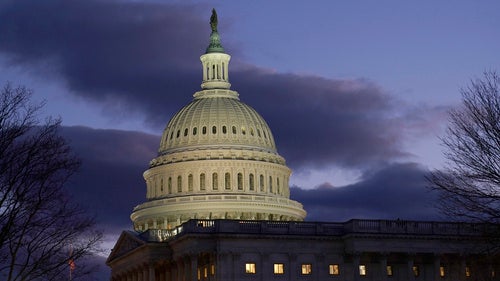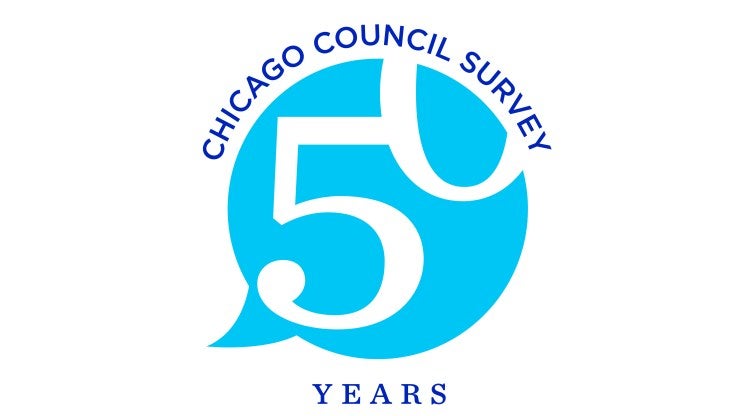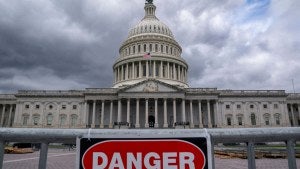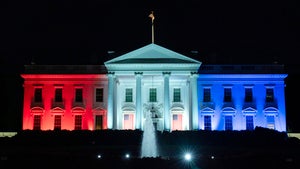Americans Sound the Alarm over Corruption and Democratic Erosion

At least half of all partisans see government corruption and weakening democracy as critical threats, but they are deeply divided on climate change and immigration.
Data from the 2025 Chicago Council Survey, fielded July 18-30, 2025, show that Americans see the internal concerns of government corruption and weakening democracy as the most critical threats to the United States. While at least half of all partisans rate these matters as critical, there are stark partisan differences on issues like climate change, immigration, and foreign adversaries.
Domestic Threats Are Top of Mind for Most Americans
Of all the possible threats to the United States, Americans rank government corruption and weakening democracy as the top two most critical threats to American interests, signaling anxieties over the health of the political system itself.
Three-quarters of Americans think US government corruption poses a critical threat to the vital interests of the United States in the next 10 years (73%), and an additional two-thirds express concern about weakening democracy in the United States (65%). The share of Americans concerned about the threat of weakening democracy has remained stable since last year (67%); this is the third year in a row that Americans are more concerned about threats within the United States than threats outside of the country.
Meanwhile, a smaller majority of Americans also say international terrorism (55%) poses a critical threat. Half characterize Iran’s nuclear program (51%), technological advancements in warfare (51%), and the development of China as a world power (50%) similarly. Climate change (49%), North Korean nuclear development (49%), and a global economic downturn (49%) are also viewed as critically threatening to about half of Americans.
The least threatening issues for Americans include the military power of Russia (44%), large numbers of immigrants and refugees coming into the United States (36%), and the lack of a peace agreement between Israel and the Palestinians (33%).
Republicans Look Outward . . .
Just a third of Americans overall view large numbers of immigrants and refugees coming into the United States as a critical threat to American interests in the next 10 years. But for supporters of the Republican Party, immigration remains the most critical threat to the United States (68%)—though tied with international terrorism (68%) and the development of China as a world power (66%).
Republican concerns over immigration have declined since last year, at which point 83 percent considered it a critical threat (the highest level recorded by the Chicago Council since 1998), and returned to levels recorded during US President Donald Trump’s first administration. This trend suggests Republicans are less threatened by immigrants when Trump is in office and taking measures to reduce immigration to the United States, as he has over the last several months.
Also high on Republicans’ radars are the nuclear ambitions of foreign adversaries like Iran (64%) and, to a lesser degree, North Korea (55%); yet just four in 10 Republicans consider Russia’s military power a critical threat (41%). Six in 10 Republicans also consider US government corruption a critical threat to the United States (61%). Half see technological advancements in warfare (52%) and weakening democracy in the United States (49%) as critical threats to American interests. The share of Republicans who are concerned about weakening democracy has declined significantly since last year (62%), perhaps because the GOP now has control of both the White House and Congress.
While the economy and inflation carried the greatest weight in their vote for a president in 2024, Republicans don’t seem too concerned about the prospect of a global economic downturn this year, as just a third view it as a critical threat (35%). Finally, Republicans view the lack of a peace agreement between Israel and the Palestinians (25%) and climate change (14%) as the least critically threatening issues to the United States.
. . . While Democrats Look Inward
Democrats, on the other hand, view weakening democracy in the United States (82%) and US government corruption (82%) as top threats. Democrats’ high level of concern over democratic erosion is not unique to Trump’s second term; last year, during the Biden administration, three-quarters of Democrats viewed weakening democracy in the United States a critical threat (75%). This suggests a broader and more enduring concern over democracy that is not contingent upon the party holding office.
A majority of Democrats also view climate change (77%) and a global economic downturn as a critical threat to the United States (61%), perhaps as a result of Trump’s reversal of climate policies and destabilizing international trade and tariff policies. Among the least critical to Democrats are threats to the United States coming from abroad, like international terrorism, high-tech warfare, foreign adversaries, and enduring conflict in the Middle East.
Conclusion
Overall, Americans are sounding the alarm over corruption and democratic erosion in the United States. But the data show that Democrats, in particular, are most concerned over the health of American political system. Republicans, on the other hand, tend to express greater concern for threats and competition from abroad. Independents tend to view threats to the United States through the same lens as Democrats, since they also consider government corruption and weakening democracy the most critical threats to American interests.
This analysis is primarily based on data from the 2025 Chicago Council Survey of the American public on foreign policy, a project of the Lester Crown Center on US Foreign Policy.
The 2025 Chicago Council Survey was conducted July 18-30, 2025, by Ipsos using its large-scale nationwide online research panel (KnowledgePanel) in English and Spanish among a weighted national sample of 2,148 adults 18 or older living in all 50 US states and the District of Columbia. The margin of sampling error for the full sample is ±2.2 percentage points, including a design effect of 1.07.
Partisan identification is based on how respondents answered a standard partisan self-identification question: “Generally speaking, do you think of yourself as a Republican, a Democrat, an Independent, or what?”
The 2025 Chicago Council Survey is made possible by the generous support of the Crown family and the Korea Foundation.
The data for the total sample were weighted to adjust for gender by age, race/ethnicity, education, Census region, metropolitan status, and household income using demographic benchmarks from the 2024 March Supplement of the Current Population Survey (CPS). The specific categories used were:
- Gender (Male, Female) by Age (18–29, 30–44, 45-59 and 60+)
- Race/Hispanic Ethnicity (White Non-Hispanic, Black Non-Hispanic, Other, Non-Hispanic, Hispanic, 2+ Races, Non-Hispanic)
- Education (Less than High School, High School, Some College, Bachelor or higher)
- Census Region (Northeast, Midwest, South, West)
- Metropolitan status (Metro, non-Metro)
- Household Income (Under $25,000, $25,000-$49,999, $50,000-$74,999, $75,000-$99,999, $100,000-$149,999, $150,000+)
Question 5
Below is a list of possible threats to the vital interests of the United States in the next 10 years. For each one, please select whether you see this as a critical threat, an important but not critical threat, or not an important threat at all.
| Overall | Republican | Democrat | Independent | R-D Gap | |
|---|---|---|---|---|---|
| 1998 | 55 | 56 | 58 | 51 | -2 |
| 2002 | 60 | 58 | 62 | 57 | -4 |
| 2004 | 52 | 62 | 49 | 50 | 13 |
| 2006 | 51 | 63 | 46 | 44 | 17 |
| 2008 | 51 | 63 | 46 | 44 | 17 |
| 2010 | 51 | 62 | 41 | 51 | 21 |
| 2012 | 40 | 55 | 30 | 40 | 25 |
| 2014 | 39 | 55 | 21 | 42 | 34 |
| 2015 | 44 | 63 | 29 | 46 | 34 |
| 2016 | 43 | 67 | 27 | 40 | 40 |
| 2017 | 37 | 62 | 21 | 35 | 41 |
| 2018 | 39 | 66 | 20 | 37 | 46 |
| 2019 | 43 | 78 | 19 | 42 | 59 |
| 2020 | 32 | 61 | 13 | 26 | 48 |
| August 2021 | 42 | 74 | 22 | 38 | 52 |
| March 2022 | 34 | 68 | 12 | 29 | 56 |
| 2022 | 39 | 70 | 18 | 37 | 52 |
| 2023 | 42 | 72 | 18 | 39 | 54 |
| 2024 | 50 | 83 | 27 | 45 | 56 |
| August 2024 (FP6) | 45 | 78 | 22 | 42 | 56 |
| 2025 | 36 | 68 | 14 | 32 | 54 |
| Overall | Republican | Democrat | Independent | R-D Gap | |
|---|---|---|---|---|---|
| 2008 | 39 | 19 | 58 | 40 | -39 |
| 2010 | 34 | 16 | 50 | 34 | -34 |
| 2012 | 32 | 15 | 44 | 33 | -29 |
| 2014 | 35 | 12 | 51 | 35 | -39 |
| 2015 | 40 | 17 | 58 | 38 | -41 |
| 2016 | 39 | 18 | 57 | 35 | -39 |
| 2017 | 46 | 15 | 67 | 47 | -52 |
| 2019 | 54 | 23 | 78 | 54 | -55 |
| January 2020 | 51 | 19 | 77 | 51 | -58 |
| 2020 | 50 | 21 | 75 | 48 | -54 |
| March 2021 | 54 | 17 | 80 | 56 | -63 |
| August 2021 | 53 | 18 | 81 | 53 | -63 |
| March 2022 | 48 | 15 | 73 | 51 | -58 |
| 2022 | 54 | 20 | 81 | 54 | -61 |
| 2023 | 52 | 16 | 82 | 51 | -66 |
| 2024 | 47 | 17 | 72 | 48 | -55 |
| August 2024 (FP6) | 49 | 20 | 77 | 50 | -57 |
| 2025 | 49 | 14 | 77 | 50 | -63 |
| Overall | Republican | Democrat | Independent | R-D Gap | |
|---|---|---|---|---|---|
| 1998 | 84 | 88 | 83 | 84 | 5 |
| 2002 | 91 | 90 | 94 | 88 | 4 |
| 2004 | 75 | 88 | 71 | 71 | 17 |
| 2006 | 74 | 85 | 76 | 64 | 9 |
| 2008 | 69 | 82 | 67 | 61 | 15 |
| 2010 | 73 | 81 | 72 | 68 | 9 |
| 2012 | 67 | 77 | 65 | 61 | 12 |
| 2014 | 63 | 66 | 61 | 61 | 5 |
| 2015 | 69 | 75 | 68 | 64 | 7 |
| 2016 | 75 | 83 | 74 | 71 | 9 |
| 2017 | 75 | 82 | 73 | 71 | 9 |
| 2018 | 66 | 74 | 61 | 64 | 13 |
| 2019 | 69 | 76 | 67 | 66 | 9 |
| 2020 | 54 | 62 | 51 | 50 | 11 |
| August 2021 | 63 | 77 | 61 | 55 | 16 |
| 2022 | 58 | 60 | 59 | 55 | 1 |
| 2023 | 52 | 59 | 50 | 47 | 9 |
| 2024 | 53 | 65 | 51 | 43 | 14 |
| 2025 | 55 | 68 | 52 | 48 | 16 |
| Overall | Republican | Democrat | Independent | R-D Gap | |
|---|---|---|---|---|---|
| 2015 | 55 | 58 | 53 | 56 | 5 |
| 2016 | 60 | 63 | 64 | 52 | -1 |
| 2017 | 75 | 80 | 76 | 70 | 4 |
| 2018 | 59 | 61 | 62 | 53 | -1 |
| 2019 | 61 | 67 | 62 | 55 | 5 |
| January 2020 | 52 | 57 | 58 | 41 | -1 |
| 2020 | 51 | 53 | 54 | 47 | -1 |
| March 2021 | 59 | 65 | 61 | 53 | 4 |
| 2022 | 52 | 57 | 55 | 45 | 2 |
| 2023 | 52 | 57 | 53 | 48 | 4 |
| 2024 | 52 | 59 | 53 | 45 | 6 |
| 2025 | 49 | 55 | 49 | 45 | 6 |
| Overall | Republican | Democrat | Independent | R-D Gap | |
|---|---|---|---|---|---|
| 2010 | 68 | 76 | 65 | 65 | 11 |
| 2012 | 64 | 75 | 60 | 58 | 15 |
| 2014 | 58 | 66 | 59 | 51 | 7 |
| 2015 | 57 | 70 | 54 | 49 | 16 |
| 2018 | 52 | 59 | 50 | 48 | 9 |
| 2019 | 57 | 70 | 52 | 51 | 18 |
| January 2020 | 61 | 73 | 62 | 51 | 11 |
| 2020 | 49 | 54 | 46 | 48 | 8 |
| March 2021 | 57 | 67 | 54 | 54 | 13 |
| 2022 | 53 | 65 | 52 | 47 | 13 |
| 2023 | 49 | 56 | 45 | 46 | 11 |
| 2024 | 53 | 62 | 52 | 45 | 10 |
| 2025 | 51 | 64 | 45 | 45 | 19 |
| Overall | Republican | Democrat | Independent | R-D Gap | |
|---|---|---|---|---|---|
| 2020 | 55 | 53 | 61 | 50 | -8 |
| March 2022 | 56 | 63 | 57 | 50 | 6 |
| 2022 | 55 | 56 | 57 | 53 | -1 |
| 2023 | 54 | 59 | 55 | 50 | 4 |
| 2025 | 49 | 35 | 61 | 49 | -26 |
| Overall | Republican | Democrat | Independent | R-D Gap | |
|---|---|---|---|---|---|
| 2014 | 26 | 29 | 27 | 22 | 2 |
| 2024 | 31 | 27 | 39 | 26 | -12 |
| 2025 | 33 | 25 | 41 | 31 | -16 |
| Overall | Republican | Democrat | Independent | R-D Gap | |
|---|---|---|---|---|---|
| 2023 | 69 | 73 | 73 | 65 | 0 |
| 2024 | 67 | 62 | 75 | 64 | -13 |
| 2025 | 65 | 49 | 82 | 63 | -33 |
| Overall | Republican | Democrat | Independent | R-D Gap | |
|---|---|---|---|---|---|
| 1990 | 33 | 32 | 34 | 33 | -2 |
| 1994 | 32 | na | na | na | na |
| 1998 | 34 | 31 | 41 | 29 | -10 |
| 2002 | 23 | 20 | 27 | 22 | -7 |
| 2017 | 41 | 32 | 50 | 39 | -18 |
| 2019 | 43 | 44 | 50 | 36 | -6 |
| 2020 | 41 | 39 | 51 | 31 | -12 |
| March 2022 | 54 | 54 | 63 | 49 | -9 |
| 2023 | 46 | 47 | 51 | 41 | -4 |
| 2025 | 44 | 41 | 51 | 38 | -10 |
| Overall | Republican | Democrat | Independent | R-D Gap | |
|---|---|---|---|---|---|
| 1990 | 40 | 37 | 43 | 40 | -6 |
| 1994 | 57 | - | - | - | - |
| 1998 | 57 | 63 | 57 | 56 | 6 |
| 2002 | 56 | 58 | 55 | 59 | 3 |
| 2004 | 33 | 45 | 29 | 32 | 16 |
| 2006 | 36 | 40 | 36 | 33 | 4 |
| 2008 | 40 | 45 | 48 | 39 | -3 |
| 2010 | 43 | 46 | 40 | 42 | 6 |
| 2012 | 40 | 44 | 38 | 39 | 6 |
| 2014 | 41 | 46 | 39 | 38 | 7 |
| 2017 | 37 | 41 | 36 | 35 | 5 |
| 2018 | 39 | 42 | 40 | 35 | 2 |
| 2019 | 42 | 54 | 36 | 40 | 18 |
| January 2020 | 38 | 41 | 37 | 37 | 4 |
| 2020 | 55 | 67 | 47 | 53 | 20 |
| March 2022 | 57 | 75 | 46 | 55 | 29 |
| 2023 | 58 | 71 | 52 | 53 | 19 |
| 2025 | 50 | 66 | 44 | 44 | 22 |
| Overall | Republican | Democrat | Independent | R-D Gap | |
|---|---|---|---|---|---|
| 2025 | 73 | 61 | 82 | 74 | -21 |
| Overall | Republican | Democrat | Independent | R-D Gap | |
|---|---|---|---|---|---|
| 2025 | 51 | 52 | 52 | 50 | 0 |



Related Content
 Public Opinion
Public Opinion
More than half also say the decline of democracies around the world, foreign interference in American elections, and the conflict in the Middle East pose critical threats to vital US interests.
 Public Opinion
Public Opinion
More Americans consider issues like weakening democracy and political polarization to be critical threats to the United States than foreign adversaries.
 US Foreign Policy
US Foreign Policy
Results and analysis of the Council's annual survey of American views on foreign policy.